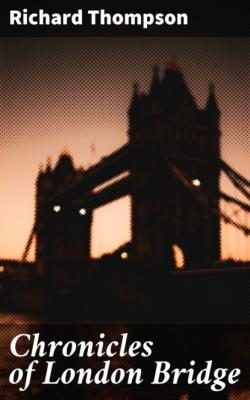ТОП просматриваемых книг сайта:
Chronicles of London Bridge. Richard Thompson
Читать онлайн.Название Chronicles of London Bridge
Год выпуска 0
isbn 4057664620606
Автор произведения Richard Thompson
Жанр Документальная литература
Издательство Bookwire
“Of this most splendid book I must, indeed, yet add another word, that it may be estimated as it so well deserves. Dr. Ducarel, in his account of that astonishing copy of it which is deposited in the Archiepiscopal Palace at Lambeth, says, ‘It was first printed at Lambeth by John Daye in 1572; and so small a number were then published, that, except this complete copy, there is but one extant in England, known to be so, which is preserved in the Public Library of Cambridge, as I am informed.’ See his Letter of July the 15th, 1758, addressed to Archbishop Secker, which is inserted in the Rev. H. J. Todd’s ‘Catalogue of the Archiepiscopal Manuscripts in Lambeth Palace.’ London, 1812, folio, page 242, Art. 959.
“The life of Archbishop Richard, which this book contains, is nearly the same as that related by Francis Godwin, Bishop of Landaff; and before I leave speaking of this early and Reverend patron of London Bridge, let me endeavour to clear his memory from something like a stain which attaches to it. He received the Archbishop’s Pall, immediately after the death of a man of unconquerable spirit and insurmountable pride, for you will remember that he was successor to Beckett: and, perhaps, it was the strong contrast afforded by his yielding and quiet disposition, which has made some suppose that he did nothing worthy of memory. I am, however, myself rather surprised at the manner of his decease, when it is allowed by all his biographers, that he was a man so charitable, of such benefit to the revenues of the church, and was so liberal both to the poor, the nation, the King, and even the Pontiff himself. The story of his death is related by Gervase of Dover, by Henry Knyghton, the Canon of Leicester, and in the Chronicle of William Thorne, the Monk of St. Augustine’s, Canterbury; but I shall recite it to you from the old English edition of Francis Godwin’s ‘Catalogue of the Bishops of England, from the first planting of the Christian Religion in this Island:’ London, 1615, 4to. page 96. ‘The end of this man,’ says the Prelate, ‘is thus reported, how that being a sleepe at his Mannor of Wrotham, there seemed to come vnto him a certaine terrible personage’—Knyghton and Thorne say ‘the Lord appeared unto his sight,’—‘demaunding of him, who he was; whereunto, when for feare, the Archbishop answered nothing, Thou art he, quoth the other, that hast destroyed the goods of the Church, and I will destroy thee from off the earth: this having said, he vanished away. In the morning betime, the Archbishop got him up, and taking his iourney toward Rochester, related this fearfull vision vnto a friend of his by the way. Hee had no sooner told the tale, but hee was taken suddenly with a great cold and stifenesse in his limmes, so that they had much adoo to get him so farre as Haling, a house belonging to the Bishop of Rochester. There he tooke his bed, and being horribly tormented with the cholike, and other greefes, vntill the next day, the night following, the 16th of February, hee gaue vp the ghost, anno 1183.’
“Though such was his untimely end, yet his being so great a benefactor to the original building of old London Bridge, ought to make his name revered by every true-hearted Citizen of London; and, indeed, Bridge-building has been thought by some to be an act of real piety, witness those rude old verses printed in Leland’s ‘Itinerary,’ volume vii. part I. Marginal folio 64 b, page 79, which were composed on the erecting of the Bridge at Culham, in Oxfordshire, and hung up by Master Richard Fannand, Ironmonger, of Abingdon, in the Hall of St. Helen’s Hospital.
‘Off alle werkys in this worlde that ever were wrought,
Holy Chirche is chefe, there children been chersid.
For by baptim these barnes to blisse been ybrought,
Thorough the grace of God, and fayre refresshed.
Another blessid besines is Brigges to make,
Where, that the pepul may not passe after greet showers;
Dole it is to drawe a deed body out of a lake,
That was fulled in a fount stoon, and a felow of oures.
King Herry the fifte, in his fourthe yere,
He hathe yfounde for his folke a Brige in Berke schyre,
For cartis with carriages may goo and come clere,
That many Wynters afore were mareed in the myre.
And some oute of ther sadels flette to the grounde
Went forthe in the water wist no man whare;
Fyve wekys after or they were yfounde,
Ther kyn and ther knowlech caught them uppe with care.’
“By this then, you see there is much virtue in your Bridge-builder. The names of all the Benefactors to London Bridge, indeed, were fairly painted on a tablet, and hung up in St. Thomas’s Chapel, which stood upon the middle of it; and, doubtless, the donation of King Henry II. would be found there recorded, if that grateful testimonial were yet in existence. The King’s gift, however, is supposed to have been, in fact, the gift of the people, being the produce of a tax upon wool; and hence arose that absurd tradition, which the commonalty invented to make a wonder of the matter, that ‘London Bridge was built upon woolpacks,’ I am, indeed, inclined to think that the measure was not very popular; for the people of England seldom failed to complain of any additional duty placed upon that commodity; and of this you find some reliques in Lord Coke’s Commentary on the 30th Chapter of the ‘Magna Charta’ of King

